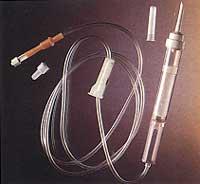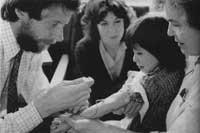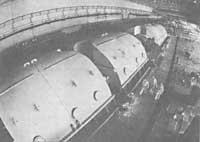Blood and blood components. Preparation and use
1992/10/01 Furundarena Salsamendi, Jose Ramon Iturria: Elhuyar aldizkaria
Anticoagulation and preservation
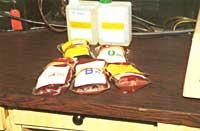
To achieve these two objectives, bags with CPDA (citrate, phosphate, dextrose, adenine) are used in the local hospitals. Blood mixed with CPDA can be used for 35 days maintaining between 1ºC and 6ºC. Red or hematite cells get the energy needed to survive from dextrose ATP and adenine. Citrate is the one that manages to keep the blood unsalted.
However, in the blood stored for 35 days some changes occur, such as, for example, the percentage of surviving red blood cells drops to 71%, somewhat acidifies the pH, decreases the level of ATP, etc. However, these changes have no clinical relevance.
Preparation of blood components
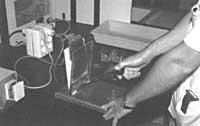
The blood extracted from the donor is collected in one of the three communicated bags, where they are mixed with CPDA. To achieve a greater utilization, the separation of blood in its components is proceeded, for which large centrifuges are used. Applying different centrifugation speeds and maintaining centrifugation at certain times, we will obtain different components.
Red blood cells or blood cells
The bags formed by these cells are called hematite concentrates. To obtain these concentrates, the plasma and platelets are removed to the blood: in the first step the centrifugation will leave the plasma and platelets in the upper part of the bag and we will pass them to the second bag through the press; in the second step another centrifugation will leave the platelets in the upper part of the plasma bag and the platelets in the lower part, so that the plasma passes to the third bag with. Therefore, three bags are obtained: a concentrate of hematites, the second platelets and the third one the plasma.
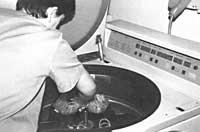
Blood bags have a volume of 500 ml, of which 450 ml will be filled with blood, the rest corresponds to CPDA. The hematite concentrate has a volume of 300 ml and the volumes of platelets and plasma are 50 ml and 150 ml respectively. The hematite concentrates will be stored in the refrigerator keeping the temperature between 1 C and 6 C. This way they can be saved for 35 days and if we exceed that deadline we will not be able to use them.
Blood fridges will show their internal temperature in two ways: in a digital marker and in a meter that marks the current temperature on a paper. This paper changes weekly or monthly and gives us the recording of the temperatures of the previous days. If the temperature rises between 1ºC and 6ºC, the refrigerator will sound an audible alarm and a light will be lit. It is convenient for refrigerators and freezers to be connected to an autonomous source independent of the hospital's electricity sources to continue operating uninterruptedly.
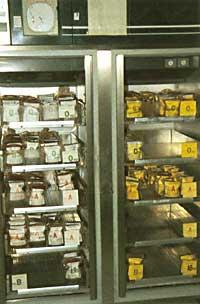
The blood is the fluid responsible for transporting oxygen to all tissues of the human body and transporting it in red blood cells or blood cells. Decreased oxygen transport capacity (hemorrhages, anemias, etc.) We can use transfusions of concentrates of hematins. However, if anemia can be cured with certain medications or medications, transfusion will not be used. As is known, blood for transfusion will be chosen according to the blood group to which it belongs (see number 55 of Elhuyar).
Plasma plasma plasma plasma
Plasma is the fluid that we have left after eliminating the cells from the blood. In addition to water and electrolytes we find albumin, gammatic globulins and clotting factors. Once the blood is donated, centrifuged as mentioned above, the plasma will be collected in a bag and to ensure the stability of the coagulation factors it will be necessary to freeze before 8 hours at a temperature below -30 C. This product is called frozen fresh plasma and can be stored for a year keeping the activity of the substances necessary for blood clotting.
Using the plasmas of many blood donors, the industry obtains a lot of useful derived products: albumin, proteins, salt to curd that are missing hemophiliacs. factor, immunoglobulin, other factors necessary for coagulation: II. VII. IX. X. etc.
Cryoprecipitation in the form of cryoprecipitation
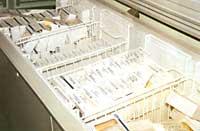
Fresh frozen plasma is an insoluble part that remains in the plasma after tempering between 1 C and 6 C. It contains 50% of the coagulation factor VIII present in the plasma of origin, 20-40% of fibrinogen and XIII. something by factor.
The only thing we will comment on is that it is useful in two situations in which there are defects in blood clotting, that is, in von Willebrand disease and hypofibrinogenemia.
Platelets Platelets
They are elements created from bone marrow cells that together with red and white blood cells are found in the blood. The role they play for the coagulation of the blood with the help of the many substances they store in some of the clusters they contain is essential. Without plates we could not live; in order not to have hemorrhages it is necessary to have a minimum of platelets.
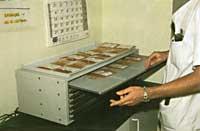
There are situations (leukemias, liver diseases, etc.) In which the platelet may appear insufficient, so they are prepared for the transfusion, as already mentioned above. The pouch formed by platelets separated by centrifugation of a pouch donated by a blood donor is called platelet concentrate or unit. It is also convenient to separate platelets when we separate the plasma from the blood, that is, before 8 hours. In the laboratory we will have platelets in a special way: At temperatures between 20ºC and 24ºC (usually room temperature) and in some non-stop mixers or rotators. If available, they can be used for 5 days.
Considerations Considerations Considerations
- When the blood is transported from place to place, it is transported between 1ºC and 10ºC and for this purpose portable cold chambers (refrigerators with dry ice) can be used.
- The frozen fresh plasma melts in warm water at 30ºC 37ºC for transfoundation and it will be necessary to transfuse in 24 hours later.
- It is essential that a label attached to the transfunder bag shows the following information clearly and visibly: the blood component, the blood group, the number of the unit, when the blood has been donated and until what day it is useful, what annexes it contains, etc.
- At the time of transfusion, filters of 170-260 children should be used to prevent the small blood that may be in the bags from passing into the stream.
- In the same vein in which blood is transfused, no other medication can be passed simultaneously, except in cases of physiological serum, plasma or albumin.
- In the first quarter of an hour the transfusion will be done slowly, since the reactions with danger appear then.

Gai honi buruzko eduki gehiago
Elhuyarrek garatutako teknologia




